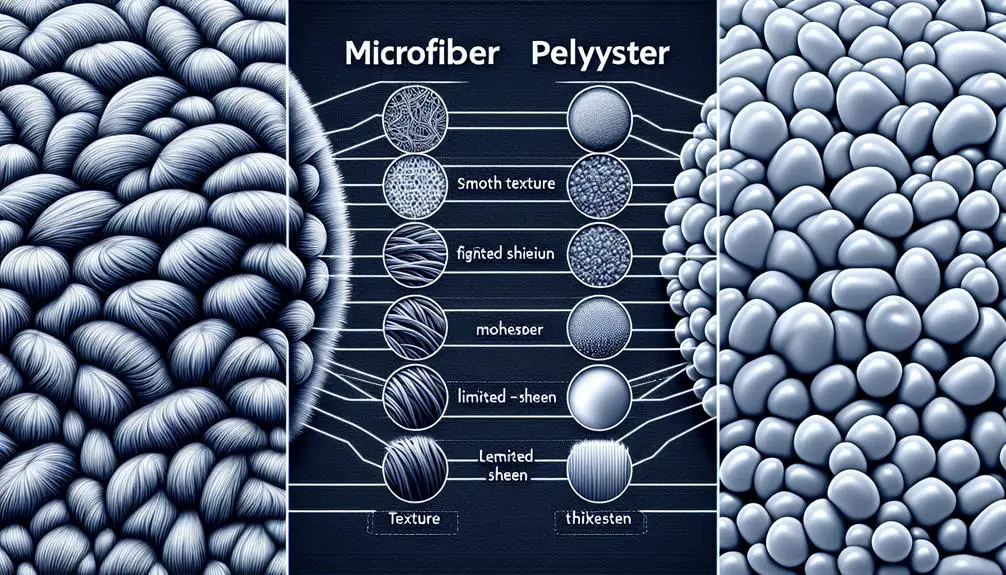Have you ever stopped to wonder, as you run your fingers over a soft blanket or cozy pair of pajamas, whether microfiber is truly just another term for polyester?
Let's unravel this textile mystery together.
The distinction between these two fabrics goes beyond mere semantics; understanding their unique qualities may reshape the way we perceive our everyday textiles.
Table of Contents
Key Takeaways
- Microfiber and polyester differ in softness, absorbency, and breathability.
- Microfiber offers a luxurious feel similar to natural fibers like silk.
- Microfiber excels in absorbency, making it ideal for towels and bedding.
- Microfiber's fine fibers and woven structure enhance comfort and performance.
Key Differences Between Microfiber and Polyester
Exploring the key differences between microfiber and polyester reveals distinct characteristics that impact their performance and comfort. Polyester, a common synthetic fabric, is known for its durability and resistance to wrinkles.
On the other hand, microfiber, also a type of polyester, stands out due to its finer fibers and unique weaving process. Microfiber surpasses traditional polyester in terms of softness, water-absorbency, and breathability, making it a popular choice for bedding like sheets and towels.
The luxurious feel of microfiber sets it apart, offering a cozy and comfortable experience. While polyester is often found in clothing and home furnishings due to its strength, microfiber finds its niche in products where a softer touch is desired.
Understanding these distinctions is crucial in selecting the ideal fabric for specific needs and preferences, whether prioritizing durability or seeking a more indulgent feel.
Fabric Composition Variations
When comparing microfiber to polyester, it's essential to consider the material properties, differences in feel, and performance in use.
These aspects highlight the variations in fabric composition and how they affect the overall characteristics of the textiles.
Understanding these distinctions can help in appreciating the unique qualities that microfiber brings to the table.
Material Properties Compared
Comparing the material properties of microfiber and polyester reveals distinct variations in fabric composition.
Microfiber, a synthetic material, boasts thinner fibers than traditional polyester fabric. These thinner fibers contribute to a tightly woven structure in microfiber sheets, offering a luxurious feel akin to high-quality cotton or silk.
On the other hand, polyester fabric, with thicker strands, may lack the smoothness of microfiber but can still provide comfort and durability.
Both types are relatively easy to care for, but microfiber tends to retain colors better over time. Understanding these differences in feel, care, and durability can help in choosing the most suitable option based on individual preferences and priorities.
Differences in Feel
Moving from understanding the material properties to examining the differences in feel between microfiber and polyester reveals distinct variations in fabric composition. When comparing polyester and microfiber, the differences in texture are quite noticeable. Polyester, being a synthetic fabric, often has a rougher feel due to its thicker fibers. In contrast, microfiber, with its finer composition, offers a soft and comfortable experience. The ultra-fine fibers in microfiber create a plush sensation, making it feel luxurious and silky to the touch. Here's a comparison table to highlight the disparities in feel between polyester and microfiber:
| Aspect | Polyester | Microfiber |
|---|---|---|
| Texture | Rougher texture | Soft and comfortable |
| Composition | Thicker fibers | Finer composition |
| Sensation | Abrasive feel | Plush and silky |
Performance in Use
How do the fabric composition variations between microfiber and polyester impact their performance in everyday use?
Microfiber, with its blend of polyester and polyamide in a split weave design, enhances absorbency and breathability, making it superior to traditional polyester. The fine fibers and woven structure of microfiber create a luxurious feel and improve comfort. Its ability to trap dirt and moisture efficiently makes it ideal for various applications like towels, bedding, and cleaning cloths.
While both microfiber and polyester are synthetic materials, the intricate weaving process and fine fibers of microfiber set it apart in terms of performance and comfort, offering a more versatile and high-performing option for everyday use.
Properties and Characteristics Comparison
When distinguishing between microfiber and polyester, it becomes evident that their properties and characteristics set them apart in terms of texture and functionality. Microfiber, known for its ultra-fine fibers, offers a soft and luxurious feel due to its finer than one denier diameter. This makes it exceptionally soft, absorbent, and breathable, making it ideal for products like towels and bedding. On the other hand, polyester, a synthetic fabric, is more commonly used in various products for its durability and affordability. Here is a simplified comparison between microfiber and polyester:
| Properties | Microfiber | Polyester |
|---|---|---|
| Texture | Soft and luxurious | Versatile |
| Absorbency | High | Moderate |
| Breathability | Excellent | Good |
| Durability | Moderate | High |
Common Misconceptions Clarified
Let's unravel some misconceptions about microfiber and polyester.
I'll clarify their material composition, explain the key differences between them, and compare their practical applications.
Let's debunk common myths and shed light on the distinct qualities of these fabrics.
Material Composition Clarified
Microfiber, often mistaken for a separate material, is in fact a type of polyester distinguished by its fine fibers and unique weaving process. When looking closely, the difference between microfiber and regular polyester becomes clearer:
- Fine Fibers: Microfiber sheets have ultra-fine fibers that are less than one denier in diameter, resulting in a soft and almost silky texture.
- Texture Variation: While polyester sheets typically have thicker strands, microfiber offers a softer feel similar to high-quality cotton or silk.
- Durability and Feel: Polyester is known for durability, but microfiber provides a luxurious touch with its smooth weave, resisting wrinkles and shrinkage while retaining vibrant colors.
Key Differences Explained
Amidst misconceptions, it is crucial to understand the key differences between microfiber and traditional polyester fabrics to appreciate their unique qualities fully. When comparing Microfiber vs Polyester, it's essential to note that while both contain polyester fibers, microfiber stands out due to its finer fibers and unique weaving process. The table below highlights some key distinctions between the two fabrics:
| Feature | Microfiber | Polyester |
|---|---|---|
| Fabric Made From | Synthetic fibers | Synthetic fibers |
| Texture | Softer feel | Typically coarser |
| Breathability | More breathable | Less breathable |
| Absorbency | Highly absorbent | Less absorbent |
| Feel | Luxury feel | Standard feel |
Microfiber's fine fibers contribute to its softer feel, breathability, and absorbent nature, giving it a luxurious edge over traditional polyester sheets.
Practical Applications Compared
In practical applications, it's important to understand the distinctions between microfiber and traditional polyester to make informed choices based on their unique characteristics. Here are three key differences to consider:
- Absorbency: Microfiber, due to its finer fibers and split weaving process, is more absorbent than traditional polyester. This makes it ideal for products like towels and cleaning cloths where absorbency is crucial.
- Softness and Texture: Microfiber offers a softer and more luxurious feel compared to regular polyester, mimicking natural fibers like silk. This enhanced softness and texture make it a preferred choice for items such as bedding where comfort is paramount.
- Applications: Microfiber's superior absorbency and softness make it commonly used in products like towels, bedding, and cleaning cloths, while traditional polyester is more prevalent in items where these features are less critical.
Use Cases and Applications
When considering practical applications, microfiber's versatility shines in various everyday items due to its fine polyester composition.
Microfiber, a type of fabric made from ultra-fine polyester fibers, offers unique characteristics that make it ideal for a range of uses. Its absorbent nature makes it perfect for cleaning cloths and towels, ensuring efficient moisture absorption.
Additionally, microfiber's breathability is well-suited for bedding, providing a comfortable and ventilated sleeping experience. Athletic wear also benefits from microfiber's moisture-wicking properties, keeping the body dry during physical activities.
On the other hand, polyester, a durable synthetic fabric, finds its applications in clothing, home furnishings, and outdoor gear. Known for its wrinkle resistance, polyester is a popular choice for garments and household items that require low maintenance.
Understanding the differences between microfiber and polyester helps in selecting the right fabric based on specific needs and preferences, ensuring optimal performance and comfort in various applications.
Performance and Durability Factors
One key factor to consider when evaluating the performance and durability of microfiber and polyester fabrics is their unique construction and material composition. Here are three essential points to help you understand the differences between these synthetic fabrics:
- Enhanced Softness: Microfiber is well-known for its exceptional softness, which is a result of the fine fibers used in its construction. This softness makes microfiber fabrics comfortable to wear and gentle on the skin compared to traditional polyester.
- Water-Absorbent Properties: Microfiber's water-absorbent capabilities are superior to regular polyester due to its split weave construction. This feature makes microfiber an excellent choice for towels, cleaning cloths, and other products where absorbency is crucial.
- Durability: The unique weaving process and material blend of microfiber contribute to its enhanced durability when compared to standard polyester. Microfiber fabrics are designed to withstand frequent use and washing, making them a long-lasting choice for various applications.
Environmental Impact Considerations
Considering the impact of microfiber and polyester on the environment is crucial in making sustainable fabric choices. Synthetic fabrics like polyester and microfiber contribute to environmental pollution throughout their lifecycle. These materials are not biodegradable, leading to long-term environmental harm. Microfiber, in particular, sheds microplastics when washed, further polluting oceans and water bodies. To mitigate these effects, consumers can opt for eco-friendly alternatives such as organic cotton or bamboo, which have a lower environmental impact. Making informed decisions about the fabrics we choose can guide us towards more sustainable options that help reduce our ecological footprint.
| Environmental Impact Considerations | |
|---|---|
| Synthetic Fabrics | Environmental Pollution |
| Not Biodegradable | Eco-Friendly Alternatives |
| Microplastics | Sustainable Fabric Choices |
Frequently Asked Questions
Which Is Better Polyester or Microfiber?
Microfiber offers a softer feel and better water absorbency, while polyester is more durable. Personal preferences for texture and breathability play a role in choosing between them. Each has its strengths; it depends on individual needs.
Are Microfiber Towels Polyester?
Are microfiber towels polyester? Yes, they are a blend of polyester and polyamide fibers. Polyester provides durability, while polyamide enhances absorbency and softness. This combination results in a versatile and practical cleaning tool with a smooth texture.
What Is the Meaning of Microfiber Polyester?
Microfiber polyester is a fabric blend of polyester and polyamide known for its softness and breathability. It feels luxurious like silk and is great for bedding, towels, and athletic wear. It balances durability, comfort, and moisture-wicking properties.
Is Microfiber Breathable?
Absolutely, microfiber is highly breathable due to its fine fibers, allowing for excellent airflow. Its breathability helps regulate body temperature, making it ideal for warm climates. I find it much more comfortable than polyester.
- Are Polyamide Carpets a Good Investment? Durability, Stains, and Cost - June 30, 2025
- Are Polyamide Bras a Good Choice? Pros, Cons, and Expert Opinions - June 30, 2025
- How to Eliminate Static Cling From Polyamide Fabrics for Good - June 30, 2025




